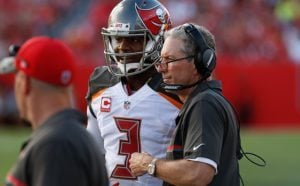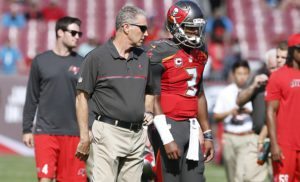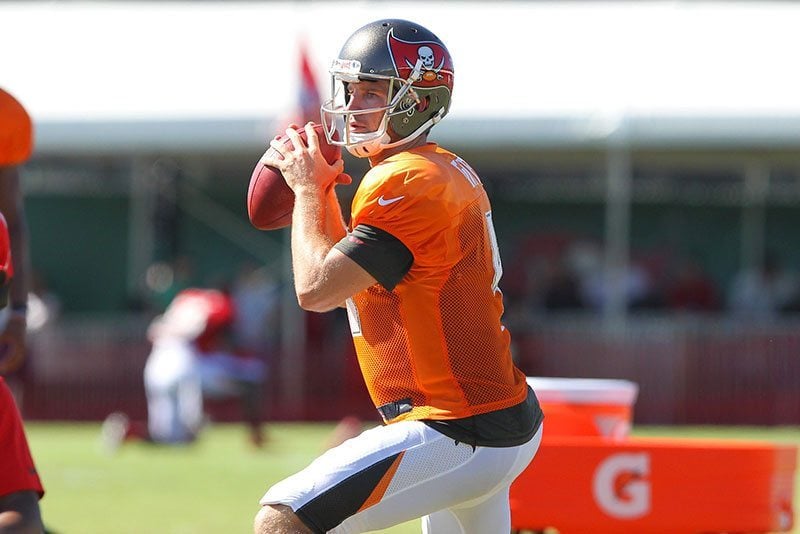Cover 3 is a weekly feature column written by PewterReport.com’s Tampa Bay Buccaneers beat writer Trevor Sikkema published every Tuesday. The column, as its name suggests, comes in three phases: a statistical observation, an in-depth film breakdown, and a “this or that” segment where the writer asks the reader to chose between two options.
Sikkema’s Stat(s) of the Week
Should I stay or should I go now?
Should I stay or should I go now?
If I go, there will be trouble
And if I stay it will be double
So come on and let me know
The world of football, much like the world around us, is often not black and white; a matter of definitive this or that. There are rarely any situations worth spending a decent amount of thought over that have an obvious answer. Rather, the situations worth the trouble often have layers and levels – context, if you will.
The Tampa Bay Buccaneers are in one of those situation with the man who leads them onto the field, in the film rooms, in the meetings, on draft night, and just about anywhere else you can expect.
Just a little over one year ago, Bucs head coach Dirk Koetter was widely thought of to be the man to bring a franchise so barren with offense in its history into the realm of relevancy and competition that followers of it are not used to – because they’ve trained themselves not to be time and time again.
“The Bucs always have been and always will be known for defense.” Right?
However, as I write this column just two weeks away from the 2017 season finale and the narrative on Koetter has almost done a 180 degree turn.
How?

Bucs QB Jameis Winston and head coach Dirk Koetter – Photo by: Cliff Welch/PR
As prefaced in the initial paragraph, there isn’t an easy answer to that question, the question of “How?” There has been plenty of blame to go around throughout the year; some deserving and others among a series of unfortunate events. Quarterback Jameis Winston getting hurt in the early part of the season gave many an excuse to throw blame out the window.
On the other side, key players such as linebackers Kwon Alexander and Lavonte David, cornerbacks Brent Grimes and Vernon Hargreaves, defensive ends Noah Spence and Robert Ayers all clocking in their time on the sidelines with injuries throw a battered and beaten narrative that doesn’t help Koetter.
But then there’s the other side of things. There were questions of physicality – or lack thereof – in training camp. Koetter talked all preseason long that the goal was just to get out of training camp as healthy as you can. A nice philosophy, in theory, but one that hinted at holes in its thought process as the Buccaneers were overpowered and ill-prepared when the good team came knocking in the early weeks.
There was the “we have to be consistent” speech that continued to resound from the podium when Koetter took center stage loss after loss after loss. There have been obvious oversights in the play calling and play structuring of an offense that was penned to have all the weapons in the world and one of the best units in football before the regular season began – yet averages less points per game this year (20.4 ppg) than a year ago (22.1 ppg).
Though it is dangerous to dive into the “what should and should not have happened” for a reality that has already passed, there is some evidence to the fact that, barring reserve safety Keith Tandy having an unprecedented end of 2016 with four key interceptions, Koetter’s record last year would not have been as good as it was. But, even beyond what the margin of wins and losses is inevitably going to be from this season to last, was an offensive regression predictable with Koetter? There’s evidence to say that it was.
*NOTE: A lot of the leg work for the following tables was done by David Harrison of the Locked on Bucs podcast. David is a great dude, a big time Bucs fan and does a lot of great work, not just on the podcast, but with outside thinking and good conversations about the team and the game. If you don’t follow his work already, you should do so!
[table id=44 /]In the table above we have the Jacksonville Jaguars offensive stats for the duration of Koetter time there.
The first thing you should notice is the year one bump. The Jaguars were the sixth best scoring offense in the NFL in Koetter’s first season, and that was with David Garrard as their quarterback. Under Koetter, Garrard threw for 28 touchdowns and just eight interceptions, a very efficient rate with the new offense.
However, after you notice the high rates from the first year, the next thing you should notice is that those numbers don’t repeat during his five-year tenure in Jacksonville. in fact, they don’t even come close. Though Garrard stayed around the same level in terms of yards throw, the total offense, including the efficiency of the quarterback took a big step drop after that year one shock change to what they were doing before. This started to become a bit of a theme on Koetter’s next stops as well.
[table id=45 /]In his first season with Matt Ryan in Atlanta, Koetter again thrived. He orchestrated the No. 7 scoring offense in the league, which helped the Falcons achieve a 13-3 record overall.
But, again, just like a regression came in Jacksonville, one also came in Atlanta. Now, fluctuation of being a Top 10 offense isn’t odd. There are plenty of coaches that experience ups and down, but Atlanta was another stop that hinted to the fact that after that initial “new” phase of Koetter as a player caller, he’s never been able to re-gain his first year achievements.
Even though the Falcons did bounce back a bit in scoring and in quarterback play during his third season, the overall output did not as the team was concerned. Being the No. 12 offense does count as holding up his side of the bargain, if you ask me, but it wasn’t enough to be offense that overcame other deficiencies. I would argue that’s a trait that exists in top coaches that can be playoff caliber.
[table id=46 /]Now comes the interesting part.
There is nothing normal about the Tampa Bay Buccaneers franchise, which means, as you would expect, Koetter’s career road has some twists and turns during his time here.
The Bucs roster was still being built from some bad coaches making bad moves, so Winston’s supporting cast during his first year has to go into the equation. The fact that it was Winston’s rookie year also had to be involved because rookies in the NFL will always have different learning curves.
But, let’s look at the three years as a whole. If we treat Winston’s second year as the first year Koetter would normally use play designs for a veteran quarterback (e.g. Garrard, Ryan), being ranked 18th isn’t too bad. But, in 2017, the Bucs offense has regressed in scoring despite tons of weapons. You can say Winston’s injury would have something to do with that, however, two of the Bucs’ highest scoring games this season, the Cardinals loss (33 points – 26 from the offense) and the Dolphins win (30 points – 23 from the offense), Winston didn’t do the majority of the scoring anyways.
Instead of nitpicking certain statistics on both sides, I’m trying to look at things with a big picture where history may be on Koetter’s side. If you divide up Winston’s stats this season and average them into a 16-game season, his numbers are actually better in the right areas. He didn’t take that “next step,” but he did show progression in efficiency (though the scoring did not). That’s the good, since Koetter does have his hands on the Bucs quarterbacks.

Bucs coach Dirk Koetter and QB Jameis Winston – Photo by Mark LoMoglio/PR
However, even with a little Winston progression, history tells me that trusting Koetter from this point on would be doing so at your own risk. After his initial jolt to a system, he’s either been figured out or has failed to adjust to what he’s done as a coach to stay one step ahead of the game. After all, you can’t run the same stuff just because it works for a year. This is the NFL, either you’re evolving or you’re dying.
Koetter, for most of his stops, hasn’t evolved, regardless of tenure length.
That’s my main gripe with Koetter as a coach. He’s in the position he’s in (a head coach and play caller for an NFL team) for a reason; he’s done some good things over his career. He’s even done them on more than one occasion for more than one team. But what happens after that? These numbers seem to say “not much.” The most important trait for a head coach or even an offensive or defensive coordinator is the ability to stay one step ahead and out-think your opponent. You want to the be one applying the pressure and forcing them to adjust, not the other way around.
Too often this season I’ve seen Koetter and the Bucs be the ones forced to react, not the one that sets the tone. Not only does that put him in a place of early adjustments, but Koetter hasn’t seemed to adjust well when those situations have come up.
Regression has been par for Koetter’s course throughout his career, and though things have fared somewhat more evenly in Tampa Bay – more importantly not too steep of a digression thus far except the Bucs record from 9-7 to a likely 4-12 – keeping him around would involve hoping you’ll see something from him that he hasn’t shown in the last 10 years as a playcaller.
The ability to catch lightning in a bottle for the second time in a single tenure.
Trevor Sikkema is the Tampa Bay Buccaneers beat reporter and NFL Draft analyst for PewterReport.com. Sikkema, an alumnus of the University of Florida, has covered both college and professional football for much of his career. As a native of the Sunshine State, when he's not buried in social media, Sikkema can be found out and active, attempting to be the best athlete he never was. Sikkema can be reached at: [email protected]


